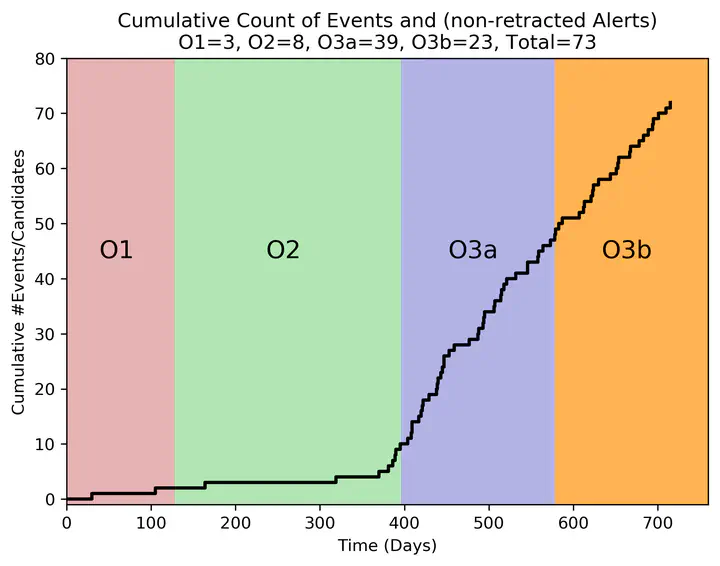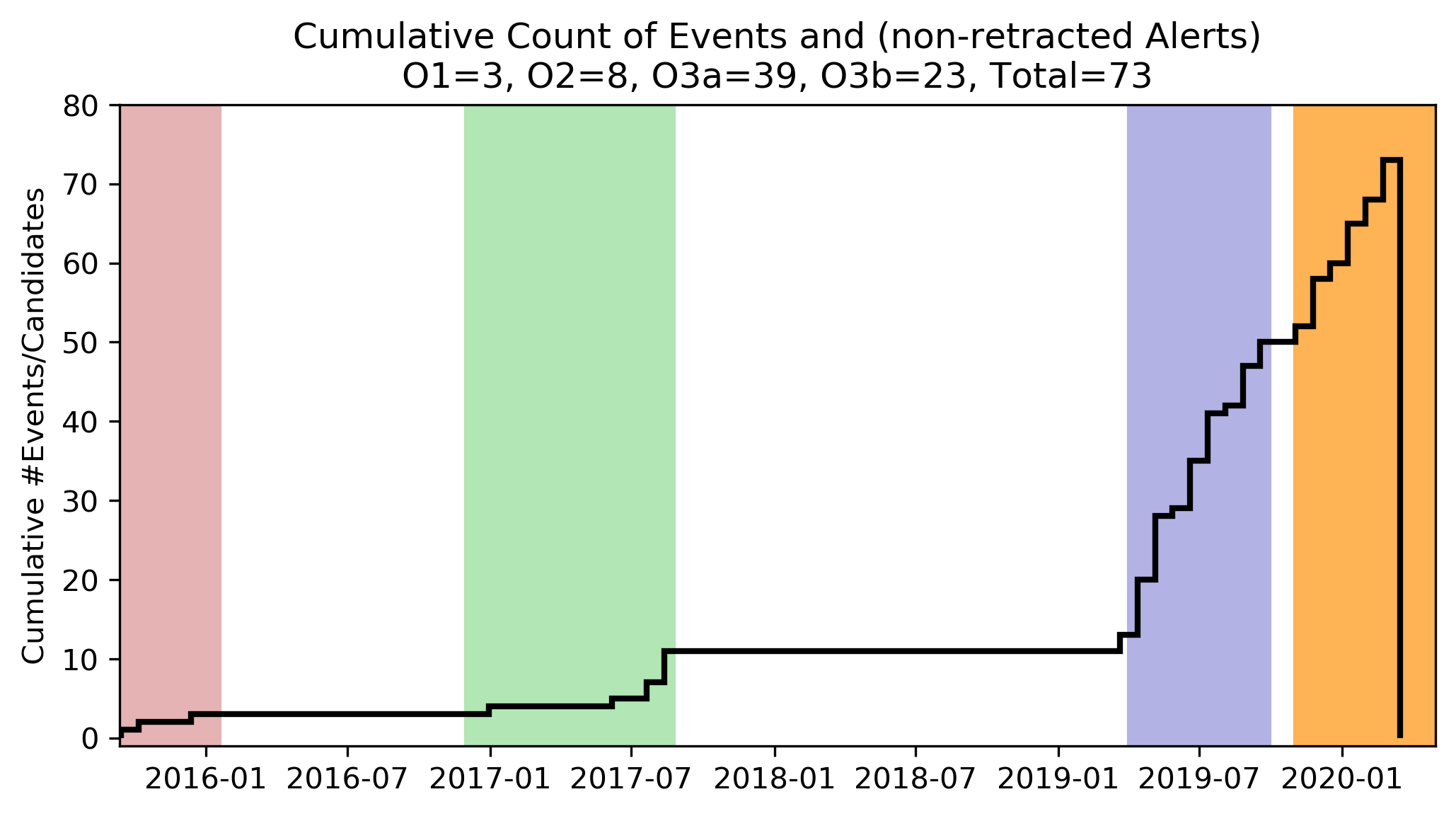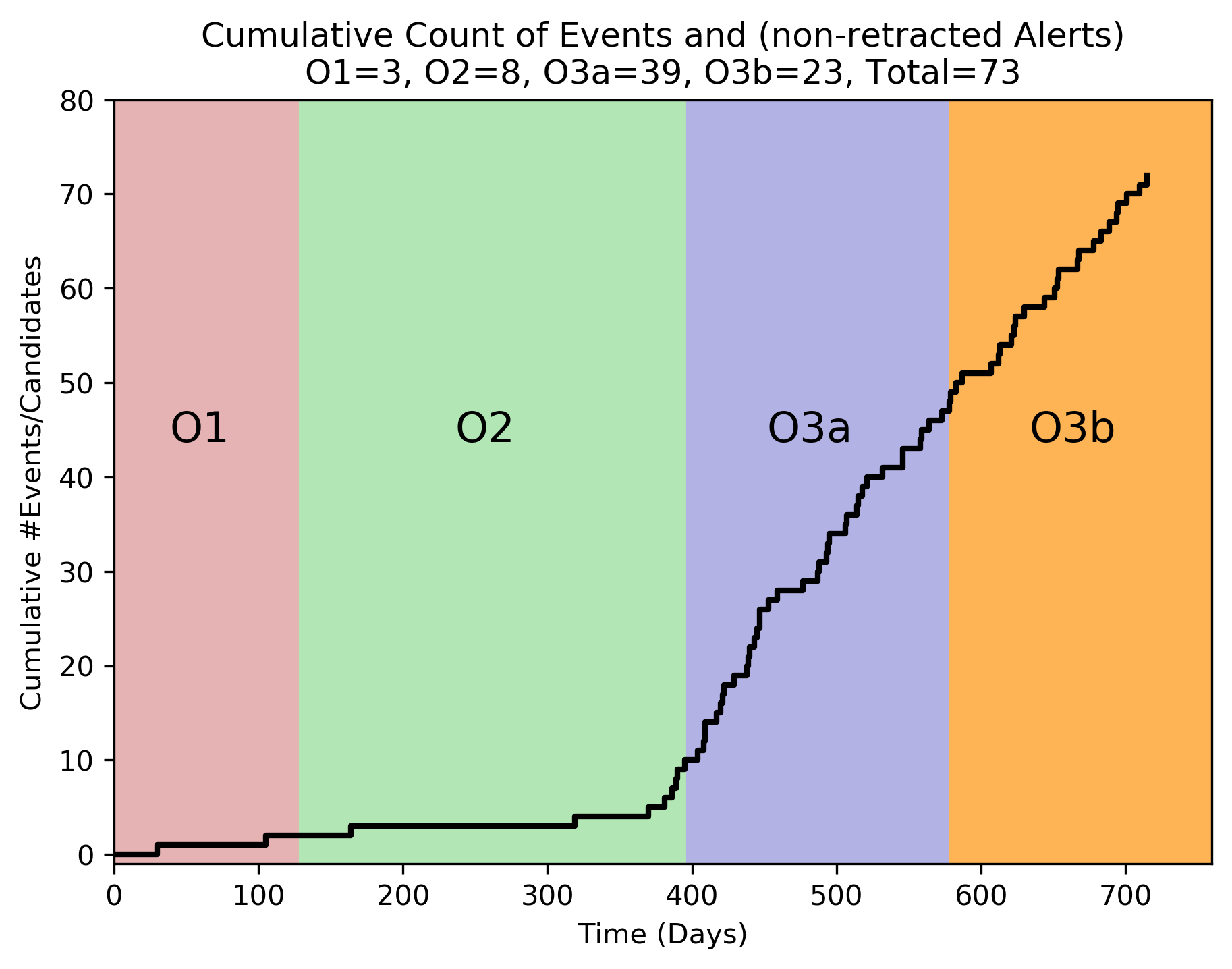 Image credit: LIGO-G2001862. Reproduced by Herb.
Image credit: LIGO-G2001862. Reproduced by Herb.数据来源 (Data Sources):
LIGO-Virgo Cumulative Event Rate Plot O1-O3a (added a separate plot to include O3b public alerts)
- LIGO-G2001862-v3 (Public)
- LIGO-G2001862-v3 (Private)
Note that G1901322 contains confirmed events and public alerts. And original cumulative event rate plot was coded in MATLAB.
Loading packages and data
import numpy as np
import datetime
import matplotlib.pyplot as plt
gw_event = [20150914,20151012,20151226, # O1 events
20170104,20170608,20170729,20170809,20170814,20170817,20170818,20170823,
20190408,20190412,20190413,20190413,20190421,20190424,20190425,20190426,
20190503,20190512,20190513,20190514,20190517,20190519,20190521,20190521,
20190527,20190602,20190620,20190630,20190701,20190706,20190707,20190708,
20190719,20190720,20190727,20190728,20190731,20190803,20190814,20190828,
20190828,20190909,20190910,20190915,20190924,20190929,20190930, # gap between O3a and O3b
20191105,20191109,20191129,20191204,20191205,20191213,20191215,
20191216,20191222,20200105,20200112,20200114,20200115,20200128,20200129,
20200208,20200213,20200219,20200224,20200225,20200302,20200311,20200316];
assert sorted(gw_event) == gw_event
datetime_event = [datetime.datetime.strptime(str(t), '%Y%m%d') for t in gw_event]
# Know more about Format Codes? see: https://docs.python.org/zh-cn/3/library/datetime.html#strftime-strptime-behavior
num_event = len(datetime_event)
print('Total number of GW events:', num_event)
Total number of GW events: 73
Pre-processing the data for drawing
O1_start = datetime.datetime(2015,9,12)
O1_end = datetime.datetime(2016,1,19)
len_O1 = O1_end - O1_start
O2_start = datetime.datetime(2016,11,30)
O2_end = datetime.datetime(2017,8,25)
len_O2 = O2_end - O2_start
O3a_start = datetime.datetime(2019,4,1)
O3a_end = datetime.datetime(2019,9,30)
len_O3a = O3a_end - O3a_start
O3b_start = datetime.datetime(2019,11,1)
O3b_end = datetime.datetime(2020,4,30)
len_O3b = O3b_end - O3b_start
total_days = len_O1 + len_O2 + len_O3a + len_O3b
O1 = len_O1
O2 = len_O1 + len_O2
O3a = len_O1 + len_O2 + len_O3a
O3b = len_O1 + len_O2 + len_O3a + len_O3b
nev_O1 = sum((O1_start <= np.asarray(datetime_event)) & (np.asarray(datetime_event) <= O1_end))
nev_O2 = sum((O2_start <= np.asarray(datetime_event)) & (np.asarray(datetime_event) <= O2_end))
nev_O3a = sum((O3a_start <= np.asarray(datetime_event)) & (np.asarray(datetime_event) <= O3a_end))
nev_O3b = sum((O3b_start <= np.asarray(datetime_event)) & (np.asarray(datetime_event) <= O3b_end))
assert num_event == nev_O1 + nev_O2 + nev_O3a + nev_O3b
print('Total of days:', total_days.days)
print('Number of days in O1/O2/O3a/O3b:', '{}/{}/{}/{}'.format(len_O1.days,len_O2.days,len_O3a.days,len_O3b.days))
print('Number of events in O1/O2/O3a/O3b:', '{}/{}/{}/{}'.format(nev_O1, nev_O2, nev_O3a, nev_O3b))
Total of days: 760
Number of days in O1/O2/O3a/O3b: 129/268/182/181
Number of events in O1/O2/O3a/O3b: 3/8/39/23
Figure: Cumulative Count of GW Events by dates.
plt.figure(figsize=(8,4))
plt.hist(datetime_event, bins=73, histtype='step', cumulative=True, color='k', linewidth=2)
plt.ylabel('Cumulative #Events/Candidates')
plt.fill_betweenx([-1,80], O1_start,O1_end , color=[230/256,179/255,179/255])
plt.fill_betweenx([-1,80], O2_start,O2_end , color=[179/256,230/255,181/255])
plt.fill_betweenx([-1,80], O3a_start,O3a_end , color=[179/256,179/255,228/255])
plt.fill_betweenx([-1,80], O3b_start,O3b_end , color=[255/256,179/255,84/255])
plt.ylim(-1,80)
plt.xlim(O1_start, O3b_end)
plt.title('''Cumulative Count of Events and (non-retracted Alerts)
O1={}, O2={}, O3a={}, O3b={}, Total={}'''.format(nev_O1,nev_O2,nev_O3a,nev_O3b,num_event))
plt.savefig('cumulative_events_by_date.png', dpi=300, bbox_inches='tight')
plt.show()

Figure: Cumulative Count of GW Events by days of running for each event.
def getstart(t):
if (O1_start <= t) & (t <= O1_end):
return O1_start
elif (O2_start <= t) & (t <= O2_end):
return O2_start - O1
elif (O3a_start <= t) & (t <= O3a_end):
return O3a_start - O2
elif (O3b_start <= t) & (t <= O3b_end):
return O3b_start - O3a
else:
raise
x = [ (t-getstart(t)).days for t in datetime_event]
y = range(len(datetime_event))
plt.figure(figsize=(7,5))
plt.plot(x, y, drawstyle='steps-post', color='k', linewidth=2)
plt.fill_betweenx([-1,80], 0, O1.days , color=[230/256,179/255,179/255])
plt.fill_betweenx([-1,80], O1.days, O2.days , color=[179/256,230/255,181/255])
plt.fill_betweenx([-1,80], O2.days, O3a.days , color=[179/256,179/255,228/255])
plt.fill_betweenx([-1,80], O3a.days, O3b.days , color=[255/256,179/255,84/255], )
plt.ylim(-1,80)
plt.xlim(0, O3b.days)
plt.ylabel('Cumulative #Events/Candidates')
plt.xlabel('Time (Days)')
plt.title('''Cumulative Count of Events and (non-retracted Alerts)
O1={}, O2={}, O3a={}, O3b={}, Total={}'''.format(nev_O1,nev_O2,nev_O3a,nev_O3b,num_event))
plt.text(O1.days*0.3, num_event*0.6, 'O1', fontsize=15)
plt.text(O1.days+(O2.days-O1.days)*0.4, num_event*0.6, 'O2', fontsize=15)
plt.text(O2.days+(O3a.days-O2.days)*0.3, num_event*0.6, 'O3a', fontsize=15)
plt.text(O3a.days+(O3b.days-O3a.days)*0.3, num_event*0.6, 'O3b', fontsize=15)
plt.savefig('cumulative_events_by_days.png', dpi=300, bbox_inches='tight')
plt.show()
